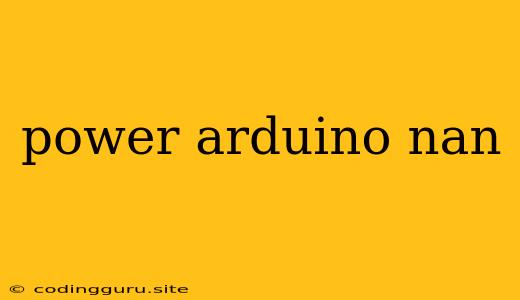Tapping into Tiny Power: Arduino Nano and Its Power Capabilities
The Arduino Nano, a miniature powerhouse of a microcontroller, has earned its place as a favorite amongst hobbyists and professionals alike. Its compact size and impressive capabilities make it an ideal choice for a wide range of projects. But how does such a small board manage to pack a punch? Let's dive into the fascinating world of the Arduino Nano's power and explore its capabilities.
Understanding the Basics of Power Consumption
The Arduino Nano, like any electronic device, consumes power to function. This power is measured in milliamps (mA). The Arduino Nano's power consumption depends on various factors, including:
- The components connected to it: LEDs, motors, sensors, and other peripherals all require different amounts of power.
- The code running on it: Complex programs can consume more power than simple ones.
- The operating voltage: The Arduino Nano typically operates at 5 volts (V).
How Much Power Does the Arduino Nano Need?
The Arduino Nano's power consumption varies depending on the scenario. However, let's look at some key figures:
- Standby: When the Arduino Nano is not running any code, it typically draws around 1mA.
- Active: With a simple program running, the Arduino Nano's power consumption could be around 50 mA.
- Heavy Load: If you are running a program that involves many LEDs, motors, or complex calculations, the power consumption could easily reach 100 mA or more.
Powering Your Arduino Nano: The Options
Powering your Arduino Nano requires a reliable source. Here are the most common methods:
- USB Power: The most convenient way to power the Arduino Nano is through a USB cable connected to a computer. The USB connection supplies 5V and typically handles the board's power needs.
- External Power Supply: For more demanding projects, you can use an external power supply. A 5V power adapter is typically recommended.
- Batteries: For portable projects, you can use batteries to power your Arduino Nano. Li-ion batteries are often preferred due to their high capacity.
Power Considerations for Your Projects
Power consumption is a crucial aspect of Arduino Nano projects. Here are some key points to consider:
- Current Limiting: If you are using high-power components, you might need to use current limiting resistors to prevent damage to the Arduino Nano or your components.
- Power Budgeting: Carefully budget the power consumption of your project. Ensure that your chosen power source can handle the load.
- Efficiency: Choose components that are efficient to minimize power consumption.
Tips for Reducing Power Consumption
- Use a sleep mode: If your project doesn't require constant processing, put the Arduino Nano into a sleep mode when it's not active. This significantly reduces power consumption.
- Optimize your code: Use efficient coding techniques to minimize the power used by the microcontroller.
- Choose low-power components: Select LEDs, motors, and other components that have a low power draw.
The Power of the Arduino Nano: Real-World Examples
The Arduino Nano's power can be harnessed for a multitude of projects. Here are some examples:
- Wearables: Its compact size makes it ideal for wearable projects, like fitness trackers and smartwatches.
- Home Automation: The Arduino Nano can control lights, appliances, and other home devices.
- Robotics: Its power can be used to control motors, sensors, and other robotic components.
- Data Logging: The Arduino Nano can be used to collect and store data from sensors.
Conclusion
The Arduino Nano's power is a testament to its versatility and utility. It allows makers, students, and professionals alike to create innovative projects that were once considered impossible with such a small footprint. By understanding the Arduino Nano's power consumption and how to manage it effectively, you can unlock its full potential and create truly remarkable projects.
